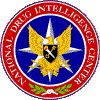ARCHIVED
![]() To Contents To Previous Page
To Next Page To Publications Page
To Home Page
To Contents To Previous Page
To Next Page To Publications Page
To Home Page
 |
National Drug Intelligence Center National Drug Threat Assessment 2005 February 2005 Steroids
Steroids, the popular name for synthetic substances related to the male sex hormones, promote muscle growth and the development of male sexual characteristics. Steroids, which are listed as Schedule III drugs under the Controlled Substances Act, are legally available only with a prescription. They are prescribed to treat conditions such as delayed puberty, some types of impotence, and body wasting in patients suffering from AIDS (acquired immunodeficiency syndrome). Steroids are abused, often by athletes, to enhance athletic performance and to improve physical appearance.
Steroids are available in tablet, liquid, gel, and cream form. The appearance of these products varies depending upon the type and the manufacturer. Users typically ingest steroids orally, inject them intramuscularly, or rub them on their skin. Individuals who abuse steroids may take doses that are 10 to 100 times higher than those used for medical conditions. Steroid abusers often take two or more different forms of the drug and mix oral steroids with injectable steroids, a process known as stacking. Abusers also frequently administer their doses in cycles of 6 to 12 weeks, a process called pyramiding. Steroid abusers believe that stacking and pyramiding enhance the benefits of the drug while lessening the toll that drug use takes on their bodies; however, there is no scientific evidence to support these theories. Individuals of various ages abuse steroids; however, it is difficult to quantify the extent of steroid abuse in the United States because many data sources that measure drug use do not include steroids. However, according to MTF, steroid use appears to be relatively low among high school students and young adults. These data show that steroid abuse among high school students has risen overall since the early 1990s but now may be declining. MTF 2004 data indicate that rates of past year use among high school students are highest among twelfth graders (2.5%), followed by tenth graders (1.5%), and eighth graders (1.1%). Between 2002 and 2004, MTF data show no significant changes in past year rates of use among twelfth graders; however, rates significantly declined among eighth and tenth graders (see Figure 63). Despite these fluctuations, MTF 2003 data indicate that past year use among adults has remained relatively stable at very low levels since 1995.
Steroid abuse appears to be higher among males than females. According to MTF, rates of past year use for steroids is higher among males than females among all age groups surveyed--eighth, tenth, and twelfth graders and young adults aged 19 to 30. Rates of past year use appear to be highest among twelfth grade males (3.2%); the rate of past year use for twelfth grade females was just 1.1 percent in the same year. Rates of past year use for steroids among eighth and tenth grade males in 2003 were 1.8 and 2.3 percent, respectively, compared with eighth (1.1%) and tenth grade females (1.1%). Drug prevalence data do not indicate a significant variation in the rates of past year steroid use among different ethnic groups. MTF data indicate that rates of past year use appear to be slightly higher among Whites in tenth (2.3%) and twelfth grades (2.4%) than Hispanics (1.8% and 1.8%) and Blacks (0.8% and 1.1%). Among eighth graders, rates of past year steroid use indicate smaller variations between Hispanics (1.7%), Whites (1.6%), and Blacks (1.2%). Data regarding the perceptions of harmfulness and disapproval of steroid use is limited. However, according to MTF data, the perceived harmfulness of steroid use has declined overall among twelfth-graders--the only grade for which such data is available--since the early 1990s (see Figure 64). The percentage of twelfth graders perceiving harm in using steroids peaked at 70.7 percent in 1992 and continued an overall decline to 55.7 percent in 2004. Similarly, MTF data regarding the disapproval of drug use by twelfth graders has also declined since the early 1990s. Twelfth graders disapproving of people using steroids peaked at 92.1 percent in 1992 and 1993 and declined overall to 87.9 percent in 2004 (see Figure 65).
Steroid abuse is associated with a range of physical and emotional problems. Physical consequences include liver tumors and cancer, jaundice, high blood pressure and increases in cholesterol levels, kidney tumors, fluid retention, and severe acne. Men may experience shrinking of the testicles, reduced sperm count, infertility, baldness, breast development, and increased risk of prostate cancer. Women may experience growth of facial hair, male-pattern baldness, changes or cessation in menstrual cycle, and deepening of the voice. Individuals who are still growing (adolescents) risk prematurely halting their growth because of early skeletal maturation and acceleration of puberty. Emotional problems associated with steroid use include dramatic mood swings (including manic symptoms that can lead to violence called roid rage), depression, paranoid jealousy, extreme irritability, delusions, and impaired judgment. In addition to the risks directly associated with steroid abuse, individuals who inject the drugs expose themselves to risks of needle-borne diseases including HIV, hepatitis B and C, and other blood-borne viruses.
OutlookSteroid use may increase among twelfth graders in the near term. MTF data for 2000 through 2004 indicate overall decreases in the rates of past year use for steroids among eighth and tenth graders; however, among twelfth graders rates of use have increased. Furthermore, MTF data indicate an overall decrease since the late 1990s in the percentage of twelfth graders who disapprove of steroid use, a possible indication of increased use in the near term. |
End of page.